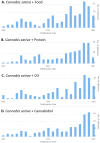Industrial Hemp (Cannabis sativa subsp. sativa) as an Emerging Source for Value-Added Functional Food Ingredients and Nutraceuticals
- PMID: 32906622
- PMCID: PMC7571072
- DOI: 10.3390/molecules25184078
Industrial Hemp (Cannabis sativa subsp. sativa) as an Emerging Source for Value-Added Functional Food Ingredients and Nutraceuticals
Abstract
Industrial hemp (Cannabis sativa L., Cannabaceae) is an ancient cultivated plant originating from Central Asia and historically has been a multi-use crop valued for its fiber, food, and medicinal uses. Various oriental and Asian cultures kept records of its production and numerous uses. Due to the similarities between industrial hemp (fiber and grain) and the narcotic/medical type of Cannabis, the production of industrial hemp was prohibited in most countries, wiping out centuries of learning and genetic resources. In the past two decades, most countries have legalized industrial hemp production, prompting a significant amount of research on the health benefits of hemp and hemp products. Current research is yet to verify the various health claims of the numerous commercially available hemp products. Hence, this review aims to compile recent advances in the science of industrial hemp, with respect to its use as value-added functional food ingredients/nutraceuticals and health benefits, while also highlighting gaps in our current knowledge and avenues of future research on this high-value multi-use plant for the global food chain.
Keywords: CBD; Cannabis sativa; cannabinoids; health benefits; hemp seed oil; oil extraction.
Conflict of interest statement
The authors declare no conflict of interest.
Figures



Similar articles
-
The seed of industrial hemp (Cannabis sativa L.): Nutritional Quality and Potential Functionality for Human Health and Nutrition.Nutrients. 2020 Jun 29;12(7):1935. doi: 10.3390/nu12071935. Nutrients. 2020. PMID: 32610691 Free PMC article. Review.
-
Hemp Seeds (Cannabis sativa L.) as a Valuable Source of Natural Ingredients for Functional Foods-A Review.Molecules. 2024 May 1;29(9):2097. doi: 10.3390/molecules29092097. Molecules. 2024. PMID: 38731588 Free PMC article. Review.
-
Effects of hemp (Cannabis sativa L.) seed oil press-cake and decaffeinated green tea leaves (Camellia sinensis) on functional characteristics of gluten-free crackers.J Food Sci. 2014 Mar;79(3):C318-25. doi: 10.1111/1750-3841.12370. Epub 2014 Feb 13. J Food Sci. 2014. PMID: 24527987
-
Applications of Cannabis Sativa L. in Food and Its Therapeutic Potential: From a Prohibited Drug to a Nutritional Supplement.Molecules. 2021 Dec 20;26(24):7699. doi: 10.3390/molecules26247699. Molecules. 2021. PMID: 34946779 Free PMC article. Review.
-
Hemp (Cannabis sativa subsp. sativa) Chemical Composition and the Application of Hempseeds in Food Formulations.Plant Foods Hum Nutr. 2022 Dec;77(4):504-513. doi: 10.1007/s11130-022-01013-x. Epub 2022 Sep 16. Plant Foods Hum Nutr. 2022. PMID: 36112300 Review.
Cited by
-
Wonder or evil?: Multifaceted health hazards and health benefits of Cannabis sativa and its phytochemicals.Saudi J Biol Sci. 2021 Dec;28(12):7290-7313. doi: 10.1016/j.sjbs.2021.08.036. Epub 2021 Aug 19. Saudi J Biol Sci. 2021. PMID: 34867033 Free PMC article. Review.
-
An In Vitro Evaluation of Industrial Hemp Extracts Against the Phytopathogenic Bacteria Erwinia carotovora, Pseudomonas syringae pv. tomato, and Pseudomonas syringae pv. tabaci.Molecules. 2024 Dec 13;29(24):5902. doi: 10.3390/molecules29245902. Molecules. 2024. PMID: 39769990 Free PMC article.
-
New crops on the block: effective strategies to broaden our food, fibre, and fuel repertoire in the face of increasingly volatile agricultural systems.J Exp Bot. 2025 May 27;76(8):2043-2063. doi: 10.1093/jxb/eraf023. J Exp Bot. 2025. PMID: 40036544 Free PMC article. Review.
-
A Stroll Through Saffron Fields, Cannabis Leaves, and Cherry Reveals the Path to Waste-Derived Antimicrobial Bioproducts.Pharmaceuticals (Basel). 2025 Jul 3;18(7):1003. doi: 10.3390/ph18071003. Pharmaceuticals (Basel). 2025. PMID: 40732292 Free PMC article.
-
Development and validation of a real-time PCR assay to detect Cannabis sativa in food.Sci Rep. 2021 Feb 26;11(1):4748. doi: 10.1038/s41598-021-83908-4. Sci Rep. 2021. PMID: 33637785 Free PMC article.
References
-
- Vonapartis E., Aubin M.P., Seguin P., Mustafa A.F., Charron J.B. Seed composition of ten industrial hemp cultivars approved for production in Canada. J. Food Composit. Anal. 2015;39:8–12. doi: 10.1016/j.jfca.2014.11.004. - DOI
-
- Callaway J.C. Hempseed as a nutritional resource: An overview. Euphytica. 2004;140:65–72. doi: 10.1007/s10681-004-4811-6. - DOI
-
- Struik P.C., Amaducci S., Bullard M.J., Stutterheim N.C., Venturi G., Cromack H.T.H. Agronomy of fibre hemp (Cannabis sativa L.) in Europe. Ind. Crops Prod. 2000;11:107–118. doi: 10.1016/S0926-6690(99)00048-5. - DOI
-
- Ranalli P., Venturi G. Hemp as a raw material for industrial applications. Euphytica. 2004;140:1–6. doi: 10.1007/s10681-004-4749-8. - DOI
Publication types
MeSH terms
Substances
LinkOut - more resources
Full Text Sources
Other Literature Sources
Medical
Miscellaneous

